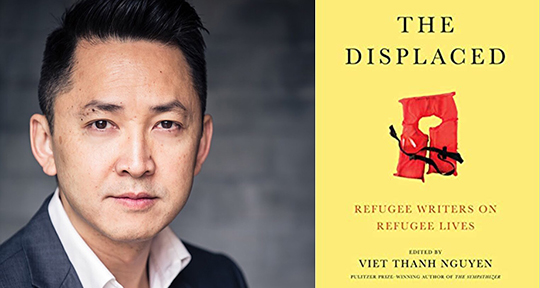To send off 2019, we’re revisiting the ten most-read articles from our issues this year. Not surprisingly, most of them were concentrated in our Spring 2019 issue, voted by 290 readers as your favorite edition this year. Scroll down to see which article was the biggest hit in a year that saw never-before-published writing from 70 countries and 44 languages spread out over four quarterly issues.
At No. 10 is Argentine author Sylvia Molloy’s thrilling but sensitive meditation on the bilingual condition from the Fall 2019 issue—read her essay “Living Between Languages.”
“to translate is to be the illegible witness of oneself.”
Our 9th most popular article of 2019 was Sarah Timmer Harvey’s interview with Raquel Salas Rivera, Philadelphia’s Poet Laureate and activist, from our Fall 2019 edition. Read and be inspired.
“Literature does not exist only because some people like to write and others like to read. It is a system that was built for centuries and we must be very careful not to destroy it.”
Miss No. 8 at your own peril—the brilliant Dubravka Ugrešić, interviewed for our Spring 2019 issue.
Coming in at No. 7: Another of Sarah Timmer Harvey’s interviews—this time with the pioneering Edith Grossman from our Summer 2019 edition: “I sometimes look at other people’s translations and think: ‘What the hell were you thinking?’”
More from the author of Why Translation Matters here.
“The magic is gone. We are at a new bend in the road.”
Our 6th most popular article in 2019 was Turkish writer Tomris Uyar’s “Tell It to Me,” a dreamlike story—published in the Winter 2020 issue—brimming with patient observation and reticent dialogue. Even so, it packs an incredible punch.
“There is no space for me as an artist or cultural figure in the west. We either need to yield to the pitiful image of the human coming from the Middle East…or else we should remain a subculture.” —Mohsen Namjoo from our Spring 2019 issue, giving us our 5th most-read article in 2019.
“Far-off worlds multiply like strange flowers from my long-sleeping body.”
Coming in at No. 4 is Christopher Burawa and Cynthia Hogue’s new translation of Steinn Steinarr, considered Iceland’s greatest modernist poet. Dive into Time and Water, published in our Winter 2020 edition.
“writing that doesn’t enact something . . . bores me to tears.”
At No. 3 is acclaimed author Maggie Nelson in a candid interview with our own Henry Ace Knight on the writing life and her National Book Critics Circle Award-winning memoir, “The Argonauts”—published in the Winter 2020 issue.
Jointly written by Jen Calleja and Sophie Collins for our Spring 2019 issue, our second most widely read article this past year argues eloquently against the lowly position that translators are sometimes accorded. Far from being “unskilled in creative interpretation,” a translator, is in fact, someone “who makes pivotal choices from the first draft to the last, and who brings their knowledge of the source and target cultures and literatures to their work.”
In an incisive conversation with Piper French for our Spring 2019 edition, Pulitzer Prize winner and MacArthur Fellow Viet Thanh Nguyen touches on everything from writing secondhand memory and Californian spaces to avoiding “trauma porn” in representing refugee stories. Revisit our most-read article from 2019 here.
*****
If you’ve enjoyed what we brought you this year, we hope you’ll read on! Communications Manager Alexander Dickow has something to get off his chest:
It would be easy to assume that Asymptote receives its fair share of support. After all, Nobel laureates like Olga Tokarczuk and Herta Müller have graced our pages, and J.M. Coetzee has even judged one of our contests! In the past nine years, Asymptote has also featured more English translations than any other journal.
But the assumption that Asymptote is richly funded would be wrong. Consider this: the National Arts Council of Singapore, where Asymptote is incorporated, does not consider editing a supportable activity. Excluded from most American and European funding because of its location, Asymptote does not have wealthy patrons. And because we do not theme our regular issues around countries, we can’t apply for funding from any one country. The fact remains that Asymptote does not favor any single voice—it favors all our voices.
What does Asymptote offer? No other journal boasts so many genres, including drama and visual art, curated to the most exacting standards. No other journal gathers such a range of voices—from as many as 36 countries in one issue. And no other journal advocates for diversity both in its pages and behind the scenes: Asymptote is assembled by a team with editors on the ground in six continents; our editor-in-chief is himself a person of color.
It takes a hard-working team of volunteers to bring you all this. But there are costs that not even a labor of love can cover.
Whether we carry on is now in your hands. For just USD5 a month—about the same price as a Sunday paper—you can help secure our future. If you can afford it, consider joining us as a patron for $500 a year or a masthead member for $1,000 a year to celebrate nine full years of publishing excellent world literature and hopefully for many more to come.
We’re now at 58 sustaining members and 2 masthead members; to operate beyond January 2020 and finish out our tenth milestone year, we need to enroll 75 more sustaining members or 9 more patrons or 5 more masthead members. Step up and help close this shortfall—in return, we’ll reward you with a special 2020 edition AsympTOTE, no matter which tier of donation you choose.












